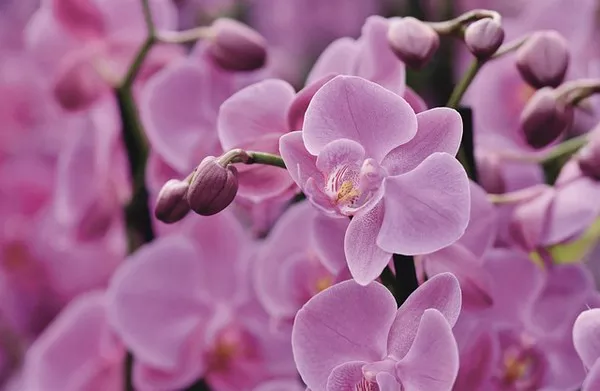Nature has gifted us with a diverse array of colors, each representing its unique charm and significance. Among these, the color pink stands out as a symbol of grace, elegance, and femininity. Pink flowers, with their delicate and alluring hues, have captured the hearts of garden enthusiasts, poets, and artists for centuries. In this comprehensive guide, we delve into the world of pink flowers, exploring their various types, meanings, and cultural significance.
The Spectrum of Pink
Pink, a color formed by mixing red and white, comes in a spectrum of shades that range from pale pastels to vibrant magentas. This variation in shades gives pink flowers a versatility that makes them suitable for a wide range of settings and occasions. From romantic gardens to soothing landscapes, pink flowers can create diverse atmospheres based on their shade and arrangement.
Popular Pink Flowers and Their Names
Pink Roses (Rosa spp.): Perhaps the most iconic pink flower, roses come in various shades of pink, each carrying its own symbolism. Light pink roses signify admiration and sympathy, while deep pink roses convey gratitude and appreciation. They are often associated with love, making them a popular choice for romantic occasions.
Pink Peony (Paeonia spp.): The peony’s lush and full blooms are a sight to behold. Pink peonies symbolize prosperity, good fortune, and a happy marriage. Their enchanting appearance and cultural significance have made them highly sought after in weddings and special celebrations.
Pink Cherry Blossoms (Prunus spp.): These delicate blossoms hold immense cultural importance, particularly in Japan. They represent the transient nature of life and beauty, making them a symbol of mindfulness and appreciation for the present moment.
Pink Tulips (Tulipa spp.): Pink tulips evoke feelings of affection and care. Light pink tulips symbolize happiness and confidence, while dark pink varieties represent gratitude and admiration. These versatile blooms are commonly used to express various sentiments in floral arrangements.
Pink Carnations (Dianthus caryophyllus): Carnations are known for their ruffled petals and longevity. Light pink carnations are associated with motherly love, while darker shades convey gratitude and admiration. They are often used in bouquets to convey heartfelt emotions.
Pink Orchids (Orchidaceae): Orchids exude an air of exotic elegance. Pink orchids symbolize femininity, grace, and joy. They are a favorite choice for adding a touch of refinement to indoor spaces and formal events.
Pink Lilies (Lilium spp.): Pink lilies are a symbol of devotion and aspiration. They are often used in religious ceremonies and are associated with purity and renewal. Pink lilies can be found in various shades, each carrying its own meaning.
Pink Hydrangeas (Hydrangea spp.): These lush blooms are known for their ability to change color based on soil pH. Pink hydrangeas represent heartfelt emotions, gratitude, and a desire to understand someone’s feelings.
Pink Azaleas (Rhododendron spp.): Pink azaleas are a springtime favorite, known for their vibrant and cheerful appearance. They symbolize femininity, romance, and care. Pink azaleas can be found in gardens and landscapes, adding a burst of color.
Pink Camellias (Camellia spp.): Pink camellias embody admiration, affection, and longing. These elegant flowers have a rich history and cultural significance, particularly in East Asia. They are often used to convey deep emotions and desires.
Cultural and Symbolic Significance
The color pink and its associated flowers carry various cultural and symbolic meanings across different societies. Here are a few notable examples:
Breast Cancer Awareness: Pink ribbons and pink flowers, particularly pink roses, have become symbols of breast cancer awareness. They represent hope, compassion, and the strength of individuals and communities coming together to support those affected by the disease.
Femininity and Romance: In many cultures, pink is associated with femininity and romance. Pink flowers are often exchanged on romantic occasions like weddings, anniversaries, and Valentine’s Day to express love and affection.
Gratitude and Appreciation: Darker shades of pink, such as deep pink roses and carnations, are often used to convey gratitude, appreciation, and admiration. They make thoughtful gifts to show recognition and thankfulness.
Cultural Traditions: In Japan, cherry blossoms (sakura) hold deep cultural significance and are celebrated during the hanami festival. These pink blossoms represent the ephemeral nature of life and the beauty of fleeting moments.
Religious Symbolism: In Christianity, pink flowers are sometimes associated with the third Sunday of Advent, symbolizing joy and anticipation. Pink flowers can also hold religious significance in other faiths and traditions.
Creating Captivating Combinations
The versatility of pink flowers allows for creative and visually appealing floral arrangements. When combined with other colors, pink flowers can evoke different moods and aesthetics.
Pink and White: The combination of pink and white creates a classic and timeless look. This pairing exudes elegance and purity, making it a popular choice for weddings and formal events.
Pink and Purple: Pink and purple create a harmonious blend of romantic and mystical vibes. This combination is often used to convey a sense of enchantment and allure.
Pink and Green: Pink flowers paired with lush green foliage offer a refreshing and vibrant arrangement. This combination is ideal for spring and summer displays, adding a pop of color to outdoor spaces.
Monochromatic Pink: Creating an arrangement using different shades of pink flowers can result in a stunning monochromatic effect. This approach highlights the various nuances of pink, showcasing its depth and variety.
Conclusion
Pink flowers, with their diverse range of shades and timeless appeal, continue to capture our hearts and imaginations. From delicate petals to bold blooms, each pink flower tells a unique story and carries its own symbolism. Whether used to convey love, gratitude, or simply to add a touch of beauty to our surroundings, pink flowers hold a special place in our gardens, celebrations, and cultural traditions. As we embrace the enchanting allure of pink flowers, we find ourselves connecting with the delicate yet powerful aspects of nature’s palette.


